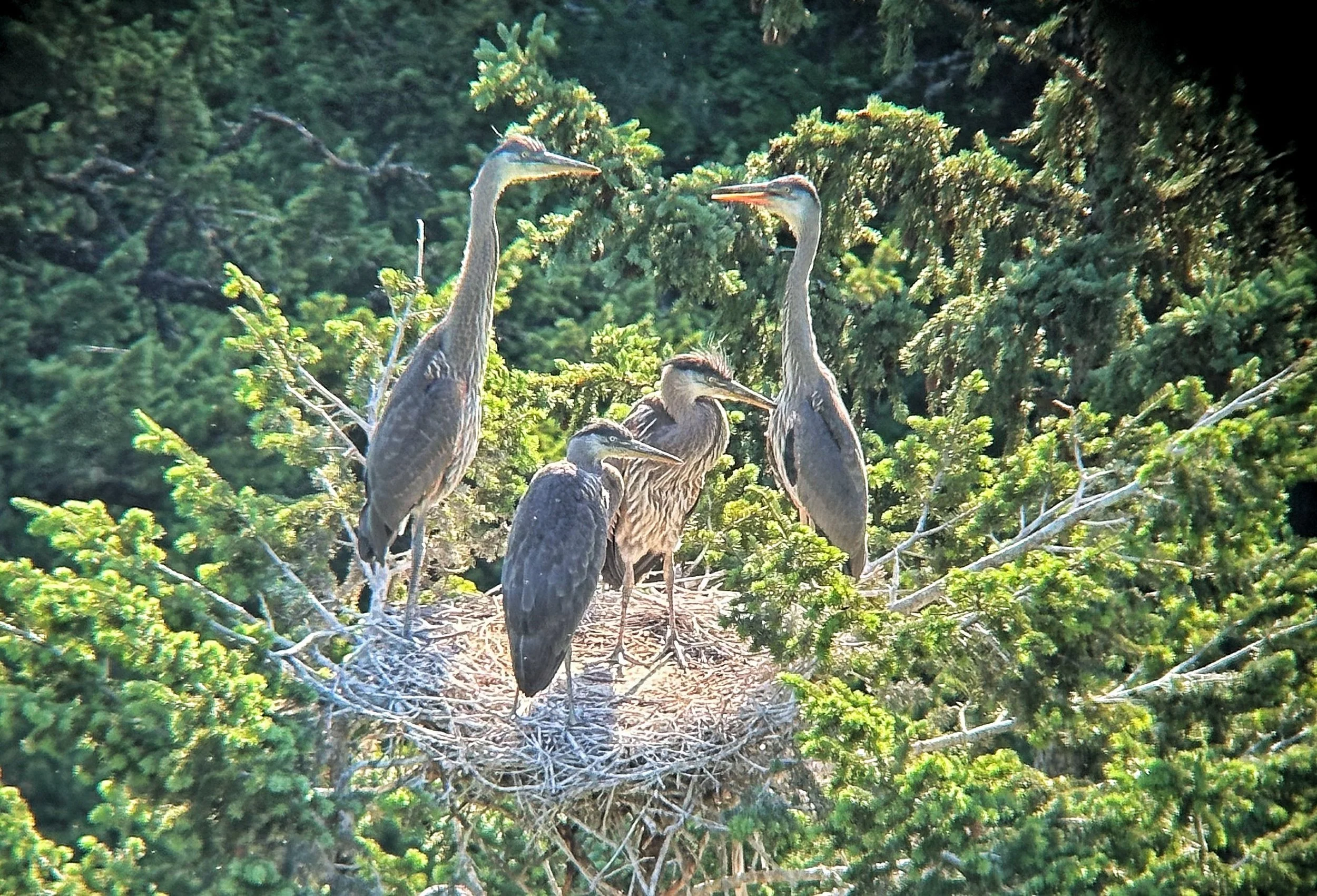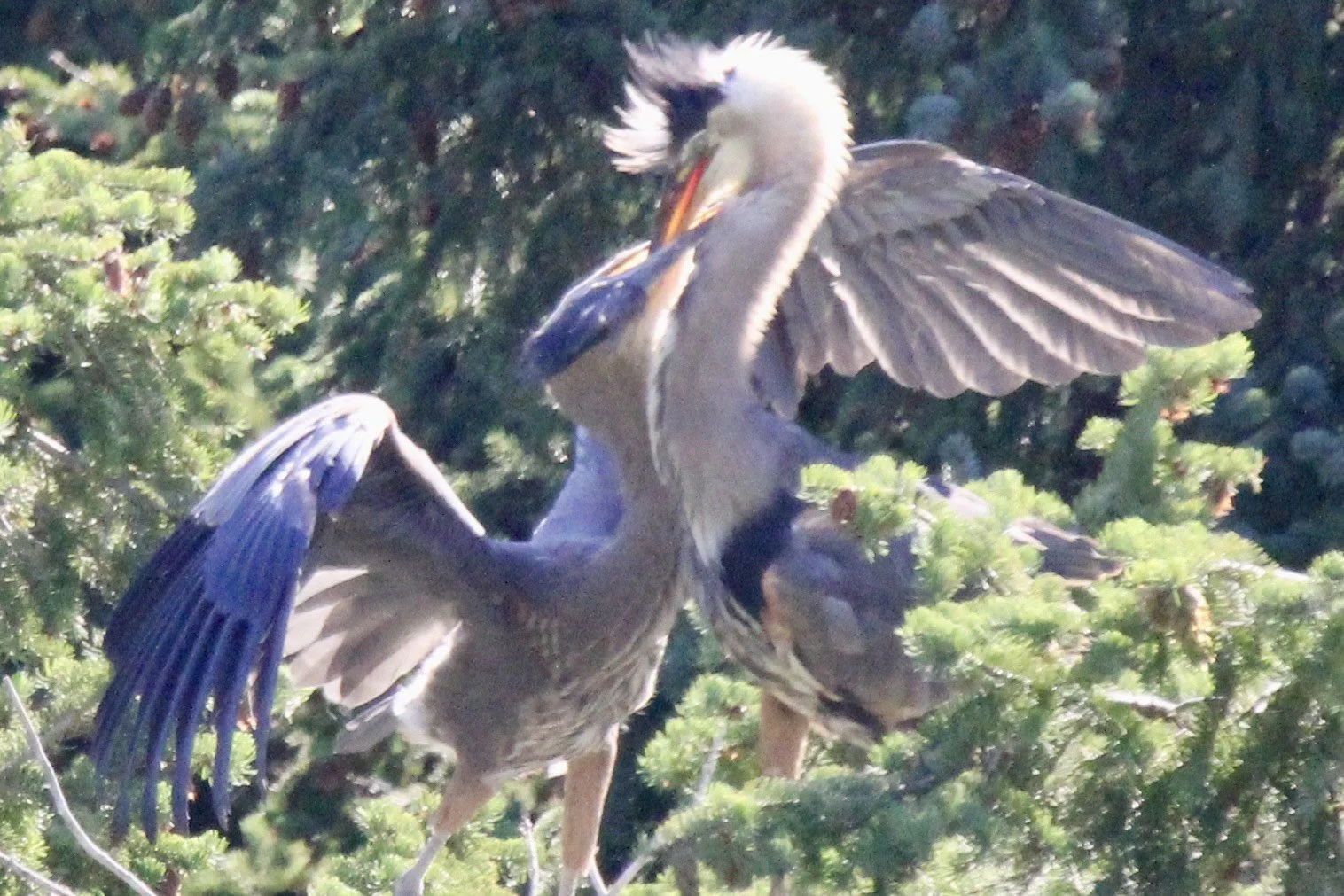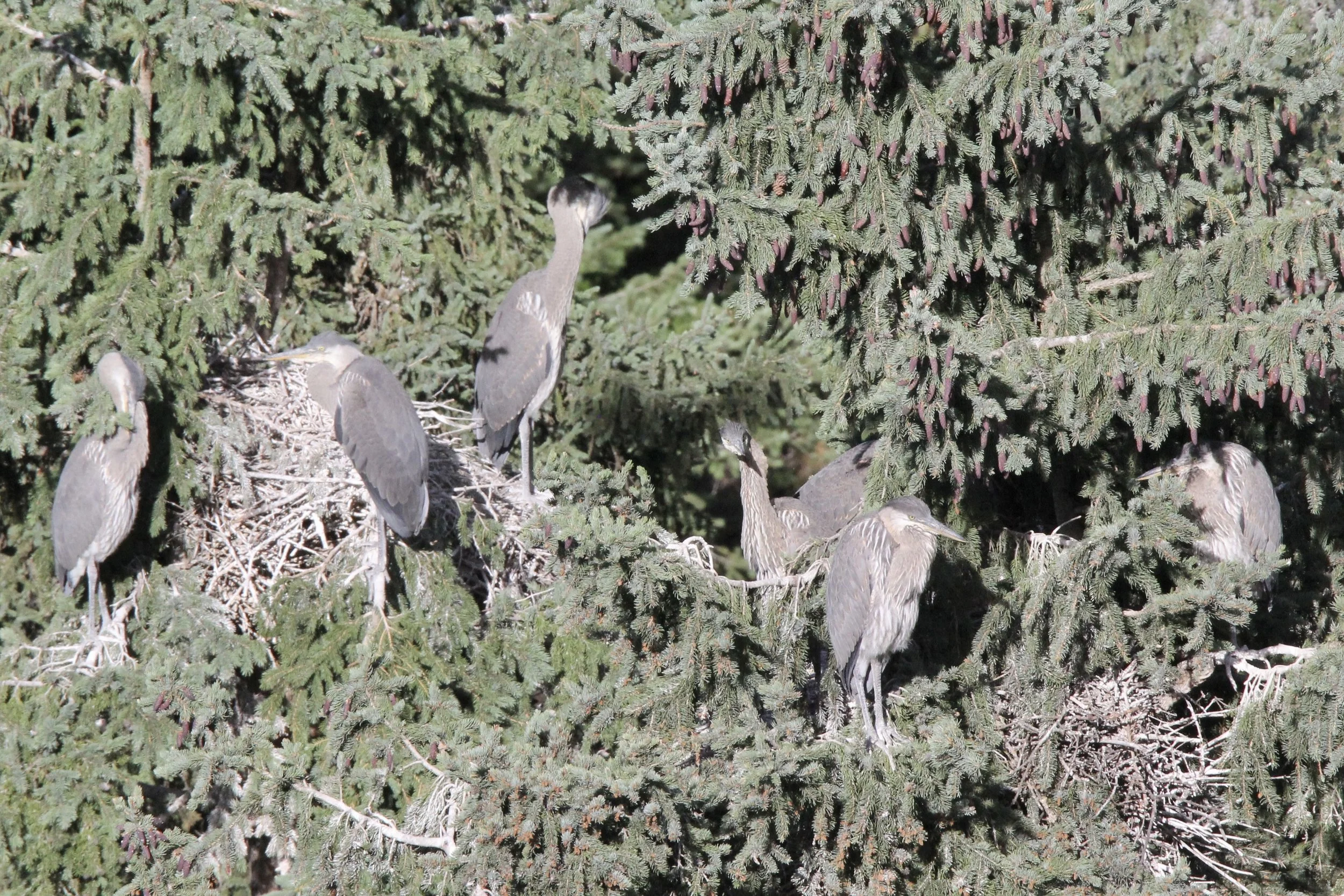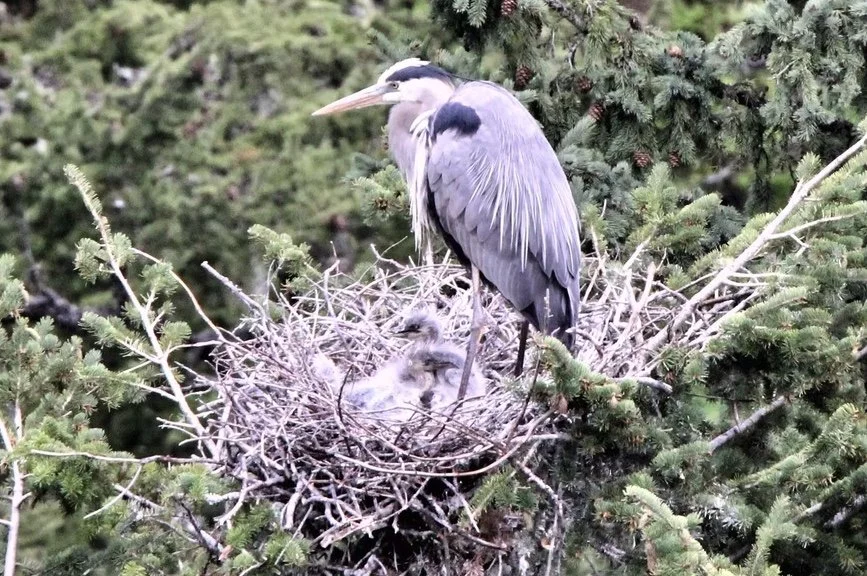Looking Back: Trouble in Paradise
Chicks in mid-June 2020 - Contributor
Part One – All About “Ardea Herodias”
On rare occasions some of us have been able to witness the slow, deep winged flight of the majestic Great Blue Heron, with is neck folded into an “S” shape and long legs extended straight out behind it. Or we have come across one standing stock still in the middle of a swamp or the edge of a lake, patiently waiting for the right moment to snag prey in their finely serrated beaks. These stealthy stately fisherman can sometimes be seen at Frank Lake, which is naught but a swamp these days, or Lee Lake or on the Crowsnest River. Nowadays sighting blue herons in the valley bottom throughout the Pass is getting rarer.
A couple of weeks ago I was invited by one of the area residents of the Adanac acreages to observe the apparently little known heron colony on Byron Creek. There was a specific reason behind the invite but in the process of being allowed to observe this gem of a heronry from their perfect vantage point, I soon became, as I am want to do, completely enthralled by this special place and its unique occupants.
How is it, I wondered, that they are where they are? Well quite simply it turns out that this heronry’s location is definitely strategic in several ways. Great Blue Herons are known to choose sites that afford protection from predators and in fairly close proximity to food sources. They are also known to prefer tall fir trees in a quiet setting. The Byron colony is in exactly that kind of location, nestled in tall firs deep in the Byron Creek gorge, a gorge whose steep sides average around 60 degrees. This affords pretty good protection from mammalian predation. The colony is located on a bend in the creek and looks for all intents and purposes like the perfect secluded spot.
I cannot tell you what a thrill it was to glass this collection of stacked nests, a stick apartment if you will, with at least 15 active nests in several trees. There are purportedly several more nest trees around the bend out of sight.
Within just about every nest one could observe several perched young nestlings, standing patiently waiting for their next meal or practicing early flapping manoeuvres in some pretty tight situations. I was also able to watch the adults fly by me, at eye level, as they headed north down the creek and out to their hunting haunts to search for food. The area around the colony trees is usually draped in a lot of white you know what which makes them easier to spot, but definitely not a place you would want to wander under.
So I wondered to myself then, what is the story on these largest members of the North American heron family? A bit of research revealed that their scientific Latin name is Ardeidae (pronounced ahr-DEE-uh-dee), a family of long-legged, long-necked migratory wading birds that also includes Bitterns. In the Herons case the wading can go up to two feet deep in the water.
There are four known subspecies of herons and two distinct colour morphs of great blues, one of which can be found in Florida and is pure white. Great blues range over most of North and Central America, northwestern South America and even the Galapagos. In late August the Byron heron families will have fledged and headed out of the nesting area, along with the adults, to make their way, hunting and growing skills until the late fall when they will head south to warmer climates.
In a study conducted in 2020 in New Brunswick, researchers attached a GPS to a heron they named Harper. When she migrated that year she flew non-stop for 68 hours from Northern New Brunswick to the southern tip of the state of Georgia. Her tracking revealed she was so far out in the Atlantic that she passed very near Bermuda. In perspective, the longest human airline flight is New York to Singapore and lasts 19 hours.
So what does this long-legged fisherman eat? Well as it turns out they have a fairly diverse menu, one that includes fish, frogs, insects, crayfish, small turtles, snakes small rodents and small birds. They have also been observed hunting voles in fields. Their size swallowing capacity is somewhat astonishing and true to Googles algorithm, as I was researching about Great Blues, a Facebook video popped up of one swallowing a huge fish that defies logic. The average blue heron is about five pounds and that fish was at least half that.
In the case of the creation of a young heron family the cycle starts with the male standing in a lined stick nest calling out to a potential mate. The sound of an adult heron is a rather unromantic harsh “garock”. Herons are seasonally monogamous but usually choose a new mate each year. There is, as you would expect of herons, a pretty exotic mating gesturing sequence with ultimately the male offering the female a stick which she builds into the nest. The stick is symbolic of acceptance and then, well, you know, they seal the deal. Later comes three to five eggs, laid at two day intervals which are incubated about 25 days. When the chicks are young they take food from the sides of the adult’s mouth but as they grow it gets a bit more aggressive.
Recently the renowned Calgary naturalist Brian Keating spent two days at the Byron heronry and captured some stunning video including this aggressive feeding behaviour. Keating stated in a CBC interview that the young can recognize their adult parents visually as they approach. He also noted that the great blue heron is now classified as a “species at risk”.
In his specially created video, the adult approaches the nest in a beautiful slow motion power down and on landing is immediately swarmed by a gang of four always hungry young ones that by now have fairly well developed wings. In short order the adult’s beak is unceremoniously hauled down into the nest where it then regurgitates its food onto the nest floor for them to eat. Keating described this scenario as “a serious wrestling match”! There can be several regurgitations to each visit and in this case there were three and all looked like a lot of minnow-like fish.
Only about one third of the young that fledge survive, with goshawks and eagles being their principal threats. Of course, as with any colony, there can be other losses caused by disturbance. In some cases the adults will abandon the nest or chicks may fall from the nest when alarmed. So privacy and quiet are critical at a heronry.
Most adults live on the average about 5 years but there is a recorded case of one that flew on to the age of 24. Keating said in a recent CBC interview on their weekday program The Homestretch that there is a heron webcam in Stanley Park in Vancouver where one can watch them live. This site has also posted short videos that depict courtship, nest building, egg laying, hatching, parenting and fledging. Oh those first precarious moments when they take the leap of faith off of the nest with their now mature wings!
Blue Herons have powder down feathers which are a specialized type of down feather that breaks down continually at their ends. The powder is keratin particles which are used to maintain their plumage, waterproof the feathers and act as a parasite control. Great Blues also have a specialized claw on their middle toe called a pectinate claw or feather comb. It is serrated on one side and acts like a comb for preening and getting rid of parasites that their beak can’t reach.
There is much to learn about these beautiful birds. As an aside my father once told me a story about walking with his father in a glen in Scotland when a heron flew over on up high. Granddad told dad in his Scottish accent, “That’s what ya call a “shitepoke”. When father asked why his dad promptly fired his gun into the air and the startling effect it had on the heron resulted in him excreting a long white streak. It is somewhat of a derogatory term but it has an apparently accepted reference in dictionaries.
My final words on Great Blue Herons are these. The collective noun for herons is “siege” and in the case of the Byron heronry, this important siege is “under siege” in a very disturbing way, the significance of which I will share in next week’s column.
Authors Note: Long time residents in the Byron Creek area assert that this colony has been around since at least the mid-1980’s. It deserves our undivided attention at protecting it.











